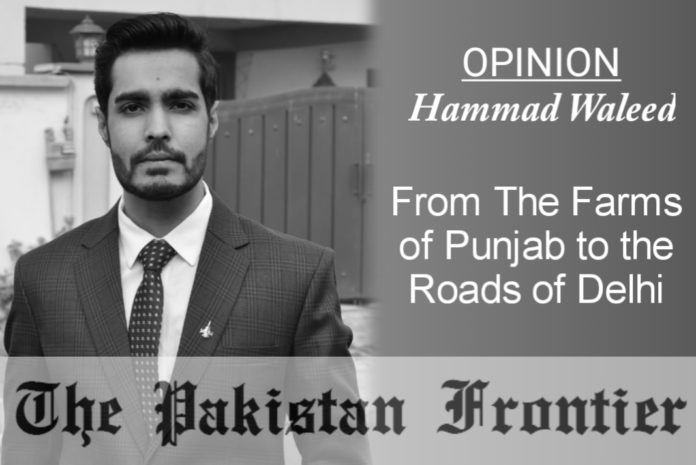As eight months of farmers protests that caught India’s capital New Delhi in a frenzy have passed. Farmer unions across multiple states have called again for the protests. Images of tractors marching in Delhi through the state’s border became a source of headlines all over the globe. Prominent international news outlets covered the story of the massive farmer demonstrations taking place in India.
The recent wave of protests has also caught the Indian states of Haryana and Rajasthan. Farmer unions stated that thousands were also on their way to Delhi from Uttar Pradesh’s Saharanpur and Sisauli areas. Under the banner of the Samyukta Kisan Morcha (SKM), farmers will stage demonstrations across the country and hand over memorandums demanding a repeal of the farm laws to the state governors
What led to the protests:
The intriguing question remains as to why thousands of farmers have left their agricultural lands to come and protest in the country’s capital. The main issue has been the adamancy of the central government to repeal the three agricultural laws : The Farmers Produce Trade and Commerce (Promotion and Facilitation) Act, 2020, Farmers (Empowerment and Protection) Agreement of Price Assurance and Farm Services Act, 2020 and The Essential Commodities (Amendment) Act, 2020. ) The BJP government , introduced three agricultural laws in September last year . The legality of the acts has been questioned since both agriculture and markets come under State or provincial jurisdiction.
The farmers categorically rejected these laws . Negotiations between the government and farmer unions have failed to result in any substantial development. From perspective of farmers, the new bills affect them direly. Farmers will be forced to sell the crop to corporate companies at one-and-a-half price. Farmers hold the view that provisions of the new law are only for the benefit of the corporate elites and not for the benefit of the farmers.
Things escalated in January when thousands of protesters entered Delhi and clashed with the law enforcement. Skirmishes took place at the Delhi Haryana border. Nearly a million farmers arrived from across the country and drove their tractors on the roads of Delhi .They have been sitting on the roads since their arrival, surrounding Delhi from all four sides, and occupying the major highways. An evident stalemate between the BJP government and farmer unions persists till date.
Protests during COVID:
While the protests made rounds in the global news, it gradually got overshadowed by another lethal crisis: India’s third COVID wave. The manner in which it hit India was unprecedented, as the country faced shortage of oxygen and crucial lifesaving supplies. India crossed the mark of 400,000 deaths from the pandemic and nearly 30.5 million cases have been reported. in total. Not only that, India also had to face new and lethal variants of Covid which included the Delta variant and Black Fungus.
The protests, although affected, remained undeterred as farmers resorted to prolonged stays in makeshift camps at the protest sites. One of the protesters while speaking to Media said that the farm laws were more dangerous to them than the Covid pandemic. While protestors have also attributed the drop in protestor number due to wheat harvesting season.
More than 400 protesting farmers have died, mostly at the protest sites around Delhi, unable to bear the hardships of the weather and living conditions .Casualties have also been attributed to police action against protests.
Politicizing the protests:
The BJP government over the course of the months of protests has tried to use repressive as well as distraction measures to quell the protests. The famous Swedish environmental activist Greta Thunberg also tweeted in favor of the farmers. Indian news channels reported police filing a FIR against Thunberg. Indian External affairs ministry called her remarks as sensationalist.
Another notable instance is painting the protests as a conspiracy of China or Pakistan . Recently, Indian security officials claimed that Pakistani based groups might try to sabotage farmer’s protests.
Even at the starting stages of the protests last year, a Union Minister Raosaheb Danve alleged that China and Pakistan have a hand behind these protests. Indian media even depicted these protests as a Pakistani conspiracy for Khalistan movement. It is notable that Sikhs form a greater part of the protesters.
Indian diaspora in foreign countries also demonstrated against the farmer laws. On another note, Indian consulate in Canada wrote to Canadian government regarding content taught in schools about the protest. The Indian consulate’s letter called teaching of such content as disinformation’.
Conclusion:
A continuous stalemate in world’s largest democracy serves as a rejoinder for those who might downplay the role of emerging populism in the Asian giant. Politicization of domestic issues by painting them as an instrument of conspiracy serves to bifurcate different groups. For a country like India, that has a diverse communal outlook, such steps can serve to alienate different religious and ethnic groups. BJP government has taken certain steps in the last few years which have been considered discriminatory in nature, especially the Citizenship Amendment Bill and now the farmer’s protest.
Lastly, an adamancy by BJP government tends to diminish the democratic culture of dialogue between protesters and administration. Persistence of farmers despite heavy rains, Covid-19, and security measures show that these protesters will not be going any sooner.
Author: Hammad Waleed
Hammad Waleed is a scholar of International Relations based in Islamabad. His interests include Discourse analysis, Foreign policy analysis, South Asian affairs, Pak-Afghan ties, Military and Strategic affairs. He can be reached at hammadwaleed82@gmail.com
